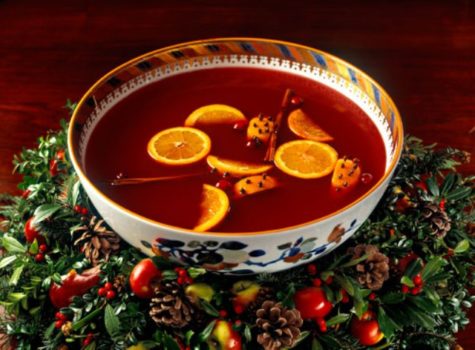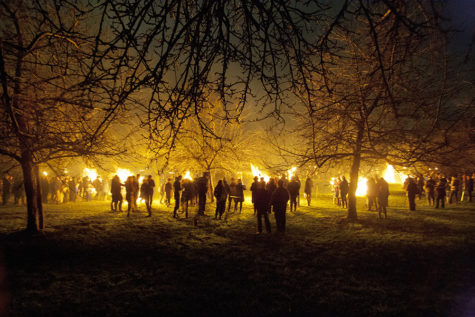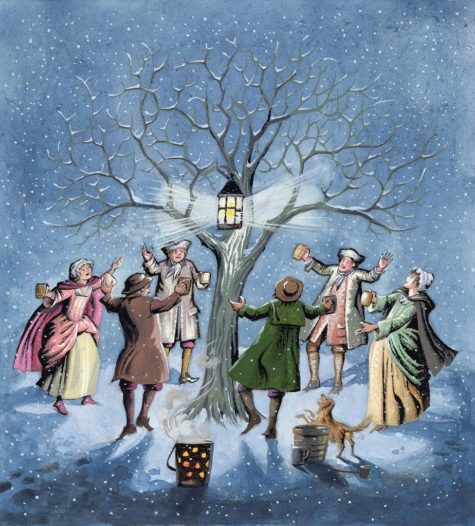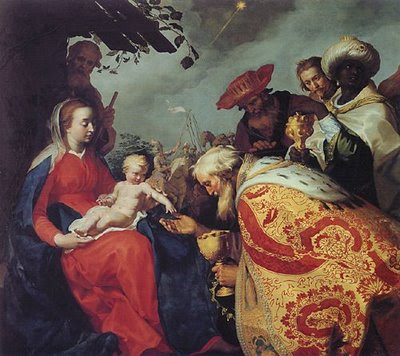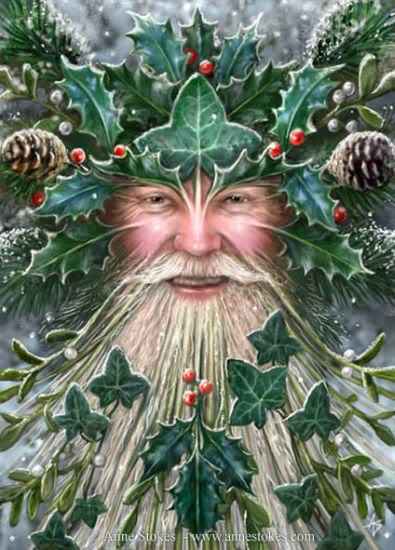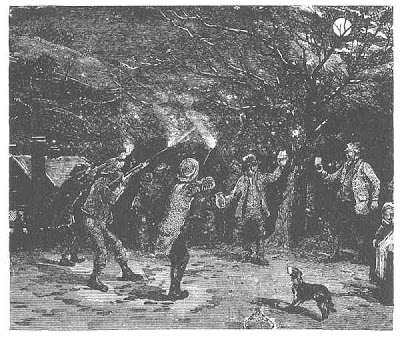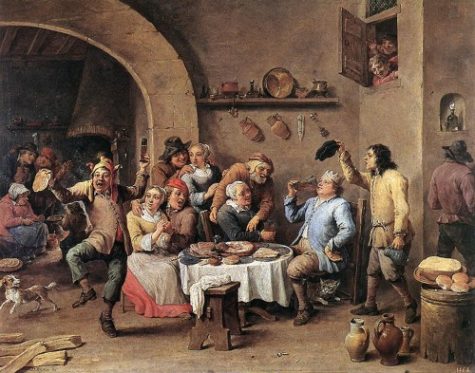Wassail
For the Wassail’s Baked Apples:
- 1 dozen cooking apples
- 1 cup brown sugar
- 3 tablespoons cinnamon
- butter or margarine
- 3/4 cup boiling water
- 2 tablespoons sugar
Core apples and place in an 8 X 8 inch baking pan. Mix sugar and cinnamon, fill apples with mixture, dot tops with butter. Add boiling water and sugar to pan and bake at 375 degrees Fahrenheit for 40 to 60 minutes.
For the Wassail:
- 1 cup water
- 4 cups sugar
- 1 tablespoon nutmeg, grated (for luck)
- 1/2 teaspoon mace
- 2 teaspoons ginger (to prevent arguments)
- 6 whole cloves (to influence people in high places, and for luck)
- 1 stick cinnamon (same as cloves)
- 6 whole allspice
- 1 dozen eggs, separated
- 4 bottles sherry
- 2 cups brandy
Combine first eight ingredients in a saucepan and boil for 5 minutes. Beat egg whites until stiff. In a separate bowl, beat egg yolks. Fold whites into yolks. Strain spice mixture into egg mixture and stir. Combine sherry and brandy and bring almost to a boil. Gradually add liquor to spice and egg mixture, stirring rapidly as you do so.
Before serving, add baked apples to foaming liquid. Serve in a large cauldron.
“Welcome everything! Welcome all alike what has been, and what never was, and what we hope may be, to your shelter underneath the holly, to your places around the Christmas fire, where what is sits.”
~Charles Dickens
The wassail—a centuries old tradition from Great Britain—is a joy-filled party celebrating the Winter Solstice, Christmastime and happy tidings. Indeed, many of the traditions of this likeable event are the originators of well-known seasonal classics (like caroling, for one).
The word wassail itself comes from the old Norse “ves heill,” which literally means “be healthy.” It is a toast of goodwill and is at the heart of what wassailing is all about.
These days a wassail is a party, but, in centuries past wassailing mainly involved people singing carols from door-to-door, such as “Here We Come a Wassailing” or “We Wish You a Merry Christmas.” Sound familiar? The carolers would carry a bowl of wassail, which was a hot mulled wine or some kind of warm, apple-based beverage. Often people floated a piece of toasted bread on top of the steaming wassail, which was the origin of our modern-day expression “I would like to propose a toast.”
When carolers entered a home they would sing, share the wassail and receive eats and drinks themselves (such as plum pudding or shepherd’s pie), at which time toasts for a merry Christmas and happy tidings for a new year would be exchanged by all.
One legend about how Wassailing was created, says that a beautiful Saxon maiden named Rowena presented Prince Vortigen with a bowl of wine while toasting him with the words ‘waes hael‘. Over the centuries, a great deal of ceremony developed around the custom of drinking wassail. The bowl was carried into a room with a great fanfare, a traditional carol about the drink was sung, and finally, the steaming hot beverage was served.
Today, wassails are still held in homes or as public celebrations in many countries throughout the world, such as Great Britain, Canada and the U.S. The celebrations can be as simple as gathering some friends for hot cider to more elaborate celebrations involving the production of short plays (called mummer plays) or caroling through apple orchards.
To host your own wassail:
- Invite friends and family to share the occasion.
- Dress up the house for a festive holiday occasion.
- Serve a warm beverage, such as spiced apple cider, mulled wine or the like, from a bowl. This is a must! Otherwise, it’s not really a wassail.
- Serve food that’s warm and hearty, like beef pot pie or warm potato wedges with bacon, cheese and sour cream toppings. Christmas pudding or any kind of spice cake or pound cake should do nicely for dessert.
- Play festive Christmas music in the background. (Or, better yet, sing along with carols if so inclined.)
- Partake in games that involve teams of players, like charades, Cranium, Pictionary or Taboo.
The object is simply to have a good time and share the joy of the season!
One of the most popular Wassailing Carols:
A Wassail Bowl
Here we come a-wassailing
Among the leaves so green,
Here we come a-wassailing,
So fair to be seen:
Love and joy come to you,
And to you your wassail too,
And God bless you and send you,
A happy New Year,
And God send you,
A happy new year.
Here is a simple wassail ceremony.
- Heat a large container of ale or beer – about 3 or 4 pints.
- Add 1/2 cup sugar and 1/4 cup mixed spices (cinnamon sticks and whole cloves are also excellent)
- Cut up 2 or 3 small sweet apples and add those.
- Add 1 1/4 cup of pineapple juice and the same of orange.
- Squeeze 2 lemons into the brew.
Place over a slow flame; then, before it begins to boil, take off the heat and whip up some cream. Let this float on top of the brew like foam. Put into a suitably large bowl (the more ornate the better).
Toast several slices of bread, if you have fruit cake you can use pieces of that instead.
Now, with a few friends, go out to the tree or trees (see note below).
Dip pieces of toasted bread into the brew and place in the branches of the tree. Hang pieces of bread and cake from the higher twigs to encourage robins (guardian spirits of the trees). Bend the lower branches down and dip their ends in the brew.
Wet the roots liberally with the brew. Pass the rest around and when everyone is thoroughly warmed up, sing a wassailing song. Lift your glasses to the tree and shout “Huzzah!” three times as loudly as you can.
Note:
These don’t have to be apple trees, since any tree will benefit from a well-intentioned blessing, but it is traditional to wassail fruit-bearing trees. You can wassail the trees in your yard, near your home, or trees in some previously selected area.
Wassailing means “to wish health to” one’s apple trees, in the hope that they will bear well. In addition, drums, bells, whistles etc. were used either to scare off evil spirits, or to wake the tree up; a libation of cider or ale was poured over the roots, and bread that had soaked in the ‘wassailing’ bowl was placed in the branches – an offering back to the tree.
Note:
Recipes for wassail are numerous and varied. Some call for the use of apple cider, some for wine. The basic idea is that you are making a hot spiced drink and serving it in a bowl amidst love and laughter. Here is a simple recipe that calls for cranberry and orange juice. Feel free to experiment and substitute.
Ingredients:
- 4 cups cranberry juice
- 1/2 cup grenadine
- 2 cups orange juice
- 1/2 cup rum (optional)
- Sugar or honey – to taste
Directions:
Put everything into a large soup or stock pot and bring to a low simmer. If you added honey or sugar, mix gently until it dissolves. Lower the heat and very low simmer the mixture for 2 hours before serving. Keep it on low or use a crockpot on low if serving over hours. The longer you heat, the more infused the flavors will be.
Orange slices or orange wedges studded with cloves, cinnamon sticks, and cranberries can be floated in the pot and simmered along with the rest of the ingredients.
When you are ready to serve your Christmas Wassail, just ladle into your favorite mug and enjoy. This delicious and warm drink is a holiday treat! Garnish with a cinnamon stick if you like.
Source: Earthwitchery
“Twelfth-day” is the twelfth day after Christmas, or Epiphany, occurring on the 6th of January. It is a festival of the Christian church in commemoration of the manifestation of Christ by the star which guided the magi to Bethlehem. “Twelfth-night” is the eve of Epiphany, when many social festivities and superstitious rites were observed. “Twelfth-tide” is the time or festival of twelfth-day. “The Twelfths” are the twelve days between Christmas and Epiphany. Epiphany is also called “Little Christmas,” being the social festival which brings the merry-makings of the Christmas cycle to an end.
A special cake, called “Twelfthcake,” is prepared for the festivities on twelfth-night. A bean or a coin is baked into it, and, the cake being divided by lot, whoever draws the slice containing it is entitled to preside as king or queen over the festivities. This custom is a relic of the old Roman festival of the Saturnalia, at the close of which the Roman children drew lots with beans to see who would be king.
A series of cards, called “Twelfth-night cards,” representing different characters such as king, queen, minister, maids of honor, or ludicrous or grotesque personages, were distributed among the guests, who had to assume the respective characters during the festivities.
A curious custom is the annual cutting of the Baddeley cake at Drury Lane Theater, London, on Twelfth-night. William Baddeley, the last actor to wear the uniform of “His Majesty’s Servants,” left £100 in bank stock, the income from which was to buy a Twelfthcake, with wine and punch, which the ladies and gentlemen were requested “to partake on every Twelfth-night in the great greenroom.”
The Devonshire farmers have an old custom of wassailing the fruit trees on the eve of Twelfth-day. They proceed with their servants, who carry large pitchers or milk pails filled with cider, to their orchards. Here one tree is selected as representative of the rest, and saluted with certain incantations; cakes are dipped in the cider and hung up on the branches, and the tree is sprinkled with the cider. They all dance merrily around it and afterward return home to feast. This is done in order that the trees should bear more fruit.
“Wassail the trees that they may bear
You many a plum and many a pear;
For more or less fruits they will bring
As you do give them wassailing.”
On twelfth-day in Ireland, they set up a sieve of oats as high as they can and in it a dozen candles. In the center is a larger one, all lighted, so as to have luck all the year.
In Styria, Austria, Epiphany is commonly called St. Bertha’s day, and it is believed that the devil is abroad in great force on that St. Bertha’s night. If one makes on that night a magic circle, and stands therein holding elder-berries gathered on St. John’s night, one would obtain the magic fern-seed which will come wrapped in a chalice cloth, and confer on one the strength of thirty or forty men.
On Epiphany, or as it is called in Bohemia, “Three Kings’ Day,” the festival of the three wise men who visited the Infant Saviour, three crosses should be made on every door, not only of the house but on the stables, pens and coops, to keep witches away. Bonfires are made at night and brooms are thrown as high as possible, all on fire, to represent the burning and the scattering of the witches. But beware that you do not point at one of the flying brooms! One of the fiery darts will pierce your finger.
When Queen Elizabeth visited Sudely Castle, Gloucestershire, about 300 years ago, on twelfthnight, “drawing the bean and pea” took place in her presence. No reason is given for the introduction of the bean and pea into the twelfth-cake, but Brand takes us to the ancient Greeks for the bean, and it may have been used on account of its mystic meaning. It was not allowed to be used for food by any of the disciples of Pythagoras lest it should be a receptacle of a departed soul, to eat which would be as impious as eating human flesh.
In Macedonia, on the 6th of January, which commemorates the baptism of Jesus Christ, a cross is thrown into the river by the priests and dived for by the men. Sick children are dipped into the water for healing. Some of this holy water, which is considered to have medicinal value, is carried home by the people, and health is insured to all who wash in it. In Kavadartsy, some of this water is used to make new leaven for the bread, and some is also thrown into the well. In Monastir straw dipped into this holy water, is wrapped around the trunks of trees to make them fruitful.
On the eve of Epiphany, the Albanians also roll a round cake to the middle of the vineyard, and then distribute it in bits for the ravens, crows, and other birds, saying: “Assemble, oh ravens, oh crows, and eat, so that we may eat and drink and you do us no harm.” This will so appeal to the honor of the birds that they will not touch the vines.
In Bohemia, the inscription “three kings” is made upon the door of the chief room of the house from the inside, every year on the 6th of January, “Three Kings’ Day” by the priest, teacher, or sexton of the town, with a blessed crayon or chalk, in the form of C x M x B x 1899 (or whatever year it may be), which means the names of Caspar, Melchior, and Balthasar, the three wise men who paid court to the Infant Jesus. This inscription protects the house from evil spirits and prevents them entering the rooms. It also brings blessings to the inhabitants. This we find of course only in Catholic families, and none of their domiciles are without it. The priest blesses the chalk for the believers, that they make inscriptions also upon the doors of their stables and barns to repel all witchcraft and magic that might do harm to the cattle or crops.
More Epiphany and Twelfth Night Lore:
- Brooms bound during the twelfths protect against witchcraft.
- Do no threshing in the twelfths, or all the corn within hearing will be spoiled.
- If cattle are fed with stolen kale (a kind of cabbage) during the twelfths, they will come to no harm.
- Whatever is dreamed during the twelfths will come to pass in the twelve months of the year.
- If a broken arm is bound five or six times round with thread spun in the twelfths, it will speedily become sound.
- In the twelfths magpies should be shot and burnt to a powder, which is good for the ague.
- Those who wear linen made from yarn spun during the twelfths will be devoured by wolves.
- No moth will come into yarn spun during the twelfths.
- If hens are fattened with peas during the twelfths, they will lay many eggs.
- At twelfth day the days are lengthened a cock’s stride.
- In the country between Hamelin and Mindcn and in other places, it is believed that no dung should be taken out of the cow house during the twelfths, else the cattle will be sick the following year.
- He who steals on twelfth-night, can steal safely for a year.
- If you eat peas or beans on twelfth-night, you will fall sick.
- On the twelfth-night the dead walk, and on every tile of the house a soul is sitting waiting for your prayers to take it out of Purgatory.
- If in the twelve-nights neither master nor man bring fresh-blackened shoes into the stables, the cattle will be bewitched.
- On twelfth-night in Scotland a board is covered with cow’s dung, candles set in it, and sprinkled with ash to make them light easily. They are then lighted, each being named for someone present, and as each dies, so will the life of the owner.
- In the “Book of Precedents,” published in London in 1616, we read that the 6th of January was five times lucky for Charles, Duke of Anjou, and equally lucky for the Earl of Sunderland.
- If a Danish girl wishes to see her future husband, she must repeat the following verse before going to bed on the eve of Epiphany: “Ye three holy kings to you I pray, That ye to-night will let me see, Whose cloth I shall spread, Whose bed I shall make, Whose name I shall bear, Whose bride I shall be.”
- Be sure for luck’s sake to spin off all the distaffs on the morrow after twelfth-day.
- The twelve days after Christmas make the almanac for the year.
- Tis thus believed in Trinity Bay, New Bedford, Mass., and Nova Scotia. In Nova Scotia it is said that the first seven days of January foretell the first seven months of the year.
- Those who do not spin in the twelfths may not wind on the 13th. (North Germany)
- In Transylvania whoever dies on the feast of Epiphany, is considered lucky.
- On the eve of Epiphany, the Albanians sprinkle the grapevines with holy water, believing that this will induce them to bear well.
Found in:
Encyclopaedia of Superstitions, Folklore, and the Occult Sciences of the World
Also known as Mithras (for the Persian Sun God), Saturnalia (for the Roman God of sowing and husbandry) and The Great Day of the Cauldron (from Druid Legend). It is the celebration of the return, or rebirth, of the Sun God, the Lord of Life. The celebrations were traditionally performed with the utmost solemnity, yet also with the highest rejoicing, for they resolve the paradox of Death and Rebirth. It represents the redemption of the world from Death and Darkness, as such it is a celebration of hope and joy amidst the gloom of winter.
The word Yule can be traced to the Celtic word `Hioul” which means wheel. This festival is an important point in the turning of the wheel of the year. Wreaths were made to symbolize this wheel, combining solar significance with tree-god significance. In ancient times Celts venerated trees as earthly representatives of the Gods, and it was felt that nothing short of the sacrifice of a mighty tree-god would cause the receding sun to take pity on them and return.
The burning of the Yule log was thought, through sympathetic magick, to increase the brightness and strength of the Sun, and would therefore bring good luck. Passersby would tip their hat or nod in salutation to the log. It is traditional to cut the log from oak or from a slow-burning fruit tree. The fire was lit from a piece of the previous years Yule log, which had been saved for this purpose. It was believed that this piece of the old log was a charm against fire, because it would refuse to burn until it was time to light its successor. A wish was also made while pouring wine over the burning log. It was believed to be bad luck if the log burned out before the 12 days of Yuletide were over. The ashes from the fire were spread in the fields to bring fertility to the next crop.
The Wassail bowl is another favored part of Yule celebrations. A large bowl or pot was filled with wassail, a mixture of cider and spices, and warmed over the Yule fire. The meaning of the word wassail is to be `hale or hearty’, and was the reason for the many toasts and salutations made from the bowl. It was also common for a procession to go to the nearest orchard and wassail the trees, thus blessing them and encouraging them to bear a good yield in the coming season. Libations of wassail were also poured over the roots of the trees, and cider drenched cakes were left in the forks of the older trees as an offering to the trees spirit.
Mistletoe is a regeneration symbol, considered to be the Essence of Life due to the resemblance of the juice of the berries to male semen. It was often gathered at this time. Evergreen boughs are also symbols of renewal. Evergreens were decorated to show honor to the tree spirits. The lights on modern trees were the candles of old, and represent the newly born sun god. Trees were not cut down and brought indoors.
The Sacred Seed of Life, having been nurtured by the foster mother Tailltiu, sprang forth from her breast, and was born. As the Wyrrd had foretold, here was the Child of Promise, son of the Gods and of the Earth. This baby was the Sun God, born in the Rule of Darkness, by the magick of the Gods. He was destined to grow in strength and knowledge. It was his task to bring back life and warmth to the land, and to wrest the power from the Lord of Darkness. To appease Cernunnos, who is at the peak of his strength, the people made sacrifices of roasted boar. To distract Callieach, the Wise Ones, or Witches invoked her to teach them of her mysteries. To aid the new-born Sun God the Celts felled a giant oak tree, and burned the log as a sacrifice, that the sun would gain strength from it, and grow.
Despite the powers of Cernunnos and Cailleach, the signs of new life were still upon the land. The sacred seeds which had fallen onto the barren branches of the winter-dead trees had come to life, and thus became the Mistletoe, which could be seen hanging from the oaks in the forests. Upon the land these sacred seeds had grown into the sweet smelling evergreens, and thus they were decreed to be a part of the celebration.
In honor of this magickal birth the people decorated the evergreens with candles and other symbols of life. The Druids told of Hu-Gadarn, the first druid, who had fled from the Atlalntean flood with his family on this day on the Ark, “The Great Cauldron” in which they brought the Essence of Life, and the knowledge of magick into the world. They would also tell tales of the Killing of the Wren, and of the Battle between the Oak King and the Holly King. Throughout the land the people rejoiced, and there was light in the midst of the darkness.
Blessed Be
~Lady Galadriel
Wassailing the trees occurred on old “twelfth night”, the 12th night after Christmas eve, or January 17th on the old calendar. (Other calendars show the date as January 5th.)
Obviously traditions varied, but in Devonshire, Herefordshire and in other parts of the West Country of England (as well as elsewhere no doubt) families would hold a feast with cakes, cider and in some areas beer and ale too. After a time of eating and drinking everyone trooped out to the orchard to wassail the trees, and wake them up from winter for the coming season as well as scare off any bad energy, spirits or demons.
Ale, beer or cider soaked toast, in some areas special cakes, would be placed in the tree branches or in a fork of the tree, and then be splashed with more cider. Trees might be beaten with sticks, pounded on, pots and pans clanged, and in appropriate eras, guns that had been loaded with just powder (no shot) would be fired at the trees.
While this went on, others in the group bowed their heads and sang the special “wassail song”.
Variations include:
Old apple tree, we’ll wassail thee
And hoping thou wilt bear
The Lord does know where we shall be
To be merry another year.
To blow well and to bear well
And so merry let us be
Let every man drink up his cup
And health to the old apple tree
(Spoken)
Apples now, hat-fulls, three bushel bag-fulls,
tallets ole-fulls, barn’s floor-fulls,
little heap under the stairs
Hip Hip Hooroo
Hip Hip Hooroo
Hip Hip Hooroo
source: Folk Info
In Old England, The Twelfth Night marked the end of the winter festival that started on Samhain. The Lord of Misrule symbolizes the world turning upside down with the coming of winter. In the middle ages, the Twelfth Night began on the eve of December 25th moving forward 12 days to January 6th, hence the name the twelve days of Christmas.
The Twelfth Night festival marked the onset of the winter solstice, the point in late December when the sun, whose daily arc had reached its lowest, darkest, coldest point, began its rise toward the longer, warmer days and the coming of spring. On December 25th, the ceremonial Yule log was hauled in to start the hearth fire around which its members and visitors would gather throughout the rest of the Christmas festival days.
Twelfth Night was the final frenzy of feasting, drinking and merry making before the townspeople returned to daily life for the remainder of winter. A grand cake was the focus of the celebratory feast as well as Wassail, Fig Pudding and other generous tasty handmade dishes.
In the ancient times of the Roman Saturnalia, the “king of the feast” was elected by beans, and the Twelfth Night cakes included a bean–or, later, a ring or coin. Whoever was given the slice with the prize became the queen and king for the night and much parading and merriment followed.
In the church calendar, Twelfth Night is the evening before Epiphany (January 6). Because the three wise men (or kings) arrived in Bethlehem bearing gifts for the infant Jesus, Epiphany is also called Three Kings Day and a traditional time of gift giving.
Sources: White Magick Alchemy and Almanac.com

